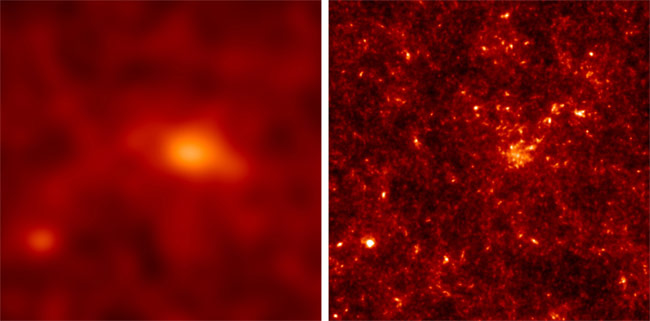
With a big enough radio telescope, astronomers could create a map detailing the structure and distribution of invisible dark matter in the universe up to 10 times sharper than previous ones made using visible light telescopes.
Scientists think the stars and glowing gas visible to optical telescopes make up only about 10 percent of the matter in the universe. The rest is thought to be a mysterious form of non-luminous matter called "dark" matter.
As befits the name, dark matter does not absorb or emit light, and is therefore invisible to current instruments. While it can't be detected directly, dark matter's presence has been implied by the effect its gravity has on light.
Gravitational lensing
Streaming light from distant stars and galaxies is bent slightly by the gravitational effects of large foregrounds objects-such as other stars, galaxies, or large dark matter clumps-that they travel past. The bending causes a detectable distortion of the images of the distant objects similar to the distortion observed in the reflections of rippled water in a lake. By measuring the strength of the distortion, scientists can calculate the strength of the gravity and mass of the foreground objects. Using this technique, called gravitational lensing, scientists have created density maps of large objects in the universe, including clumps of dark matter.
Previous maps created using optical telescopes suffer from blurriness, however, because many distant light sources are required to make a sharp image, and there are not enough visible galaxies in the sky for this. Only the very largest lumps of matter, corresponding to the very biggest galaxy clusters, can be pinpointed with any confidence on such maps.
Another problem is that many of the massive objects, such as primordial hydrogen clouds present before the first stars or galaxies ever formed, lie behind [image] the galaxies whose visible light scientists are measuring. As a result, the more ancient structures in the universe are invisible to many of today's instruments. To view these objects, scientists need many more distant light sources.
Get the Space.com Newsletter
Breaking space news, the latest updates on rocket launches, skywatching events and more!
Ancient radio waves
Radio waves could provide these sources, say Benton Metcalf and Simon White, researchers at the Max Plank Institute of Astrophysics in Germany.
Visible light from shining stars and galaxies is a relatively recent development in the history of the universe. Before the first star blazed into existence and the first galaxy shined, the universe was a dark place, pervaded by matter and energy but no light. More ancient than visible light are radio waves, some of which can be traced back to a time before galaxies.
There are also many more radio wave sources in the universe. Look in any direction in the sky, and there are up to 1,000 radio sources at different distances along that single line of sight.
About 400,000 years after the Big Bang, hydrogen and helium atoms permeated the universe. Over the course of a few hundred million years, gravity caused these gases to clump together to form dense clouds. Eventually, these clouds coalesced into the first stars and galaxies whose radiance put an end to the universe's "dark age."
Theory predicts that ultraviolet light from these early celestial bodies heated the hydrogen and helium and caused the hydrogen atoms to emit and absorb radio waves of a specific wavelength: 21 cm (8.3 inches). As the universe expanded, this wavelength expanded as well, and today should be about 2 to 20 meters (7 to 66 feet) long.
A new kind of radio telescope
In a study published in last November's issue of the Monthly Notice of the Royal Astronomical Society, Metcalf and White showed that a sufficiently large radio telescope that measures the gravitational lensing of these early universe radio waves could be used to create a density map of the universe rivaling, or even besting, today's sharpest optical telescopes [image]. The researchers predict that such a telescope could spot light from an object with a mass similar to our own Milky Way galaxy from when the universe was only 685 million years old, or about 5 percent of its predicted present age.
This kind of high-resolution imaging requires an extremely large radio telescope array, however. "To map individual galaxies, you need something like 100 km (62 miles)," Metcalf told SPACE.com. "You could have one that's smaller, but you wouldn't get as good resolution."
No radio telescope that big is currently planned, but a smaller project, called the Low Frequency Array, or LOFAR, being constructed in the Netherlands and Germany, could provide similar, albeit lower resolution, radio pictures of the sky. LOFAR's arrays will be arranged in clusters and scattered over an area about 350 km (217 miles) in diameter. However, its most sensitive core array-the part required to do the type of imaging the researchers propose-will only be about 7 km (4.34 miles) across, Metcalf said.
- The Top 5 Telescopes of All Time
- Seeing the Universe with Einstein's Glasses
- Understanding Dark Matter and Light Energy
- Dark Matter Exposed: Animation Offers Clues to Cosmic Mystery
Join our Space Forums to keep talking space on the latest missions, night sky and more! And if you have a news tip, correction or comment, let us know at: community@space.com.
Ker Than is a science writer and children's book author who joined Space.com as a Staff Writer from 2005 to 2007. Ker covered astronomy and human spaceflight while at Space.com, including space shuttle launches, and has authored three science books for kids about earthquakes, stars and black holes. Ker's work has also appeared in National Geographic, Nature News, New Scientist and Sky & Telescope, among others. He earned a bachelor's degree in biology from UC Irvine and a master's degree in science journalism from New York University. Ker is currently the Director of Science Communications at Stanford University.









